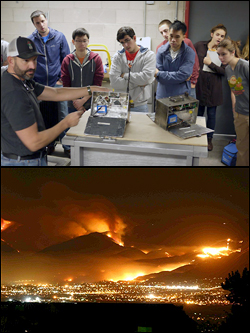News Story
Designing Communities to Withstand Wildfires

Above: Dan Jimenez from the U.S. Forest Service joined Professor Gollner's Wildland Fires class to demonstrate wildfire deployment packages, sensor-loaded cases used to collect information in real wildfires. Below: A fire aproaches the wildland-urban interface in San Diego, Ca.
“Wildfires are a global problem,” says Department of Fire Protection Engineering (FPE) assistant professor Michael Gollner. “A big one.” In the U.S. alone, these disasters, including six of the nation’s top ten most destructive fires, have destroyed 38,000 homes in the past 15 years.
“Wildfires are part of a natural ecological cycle, but we haven’t really learned to live with them,” says Gollner. “We’re making the situation worse. We need to understand these fires, before, when, and after they occur. We need to do a better job of protecting people, managing our ecosystems, and addressing global climate concerns.” But despite the growing danger, he adds, only a handful of comprehensive studies on community fire resilience have been conducted.
Because actual wildfires provide only limited opportunities to safely collect data and diagnostic information, Gollner’s research group and its collaborators use a variety of approaches to study them, from the lab to the environmental scale. These include live burns of scale models in simulated conditions, computer modeling, remote sensing, ignition experiments, characterizing the burning behavior of different fuel sources, using imagery from satellite observation systems, data assimilation, and geographical and atmospheric science.
The National Fire Protection Association (NFPA) asked Gollner to examine how fire spreads where nature meets human development (a zone called the wildland-urban interface), identify gaps in current knowledge, and propose prevention and protection strategies. He recently completed the study and co-authored a report with three FPE undergraduates from his research group: Raquel Hakes, Sara Caton, and Kyle Kohler (B.S. ’15).
There are three ways in which wildfires can ignite homes, and homes can ignite each other, Gollner explains. The first is radiative heat, which is transferred through space, and was originally thought to be the cause of most ignitions. The second is direct flame contact from small fires. Firebrands—the little embers that fly through the air—are the third and the most insidious, because they can land, smolder, and ignite miles away and hours later, far from the actual fire front. All of these paths are affected by variables including the weather, terrain, plant life, physical barriers, construction materials, and housing design and density, making wildland-urban interface fire behavior inherently difficult to predict.
Communities need to ensure they can provide sufficient water and safe zones for firefighters, an evacuation plan for residents, and multiple routes out of town. But what about the homes and property left behind?
Gollner answers the question with one of his own: “What if you design your home and community so that they can’t be ignited in the first place?”
That’s very difficult, he concedes, but there are many things communities can do that can mitigate or prevent damage. And the most important of those things, he says, is applying fire protection principles to the exterior of our homes.
“Once it’s in the community, the fire is going to travel from house to house, not tree to tree,” he explains. “Detection and suppression systems are designed for the inside of your home. But they don’t account for your roof or your attic, which is where many fires ignite. If the attic is on fire and the home’s sprinklers go off below, not only are they ineffective, they’re also wasting the water and lowering the pressure the firefighters need.”
It is imperative that old roofs should be replaced with those made from fire-resistant materials, he says. Debris must be cleared from gutters. Trees, bushes and mulch should not come within five feet the home. The lower branches of the trees in or bordering the community can be trimmed off to help keep the fire low to the ground, which reduces fire intensity and makes it easier to suppress. Homes should be built farther apart. Power lines should be buried, or at least kept clear to prevent the loss of electricity required to run water pumps, utilities, and hospitals. Towns need to think more strategically about their perimeters by examining what separates them from the wilderness, and how wide that separation is. Individual homeowners must be aware of how fire could spread from neighboring properties, and customize their protection strategies accordingly.
In Fall 2015, Gollner introduced undergraduate and graduate students to this crucial area of research in a new course, ENFP 489W/629W: Wildland Fires: Science and Applications. Students learned about designing buildings to resist ignition, wildfire spread, community planning, community resilience, NFPA and ICC Codes, and modeling tools such as FARSITE. The course also featured lectures and demonstrations from members of the U.S. Forest Service and the Maryland Department of Natural Resources Forest Service.
In their final project, the students chose between analyzing and reporting on one of two real wildland-urban interface communities in California, or designing a new resilient community in a location subject to wildfires. The creativity and variety of their proposed solutions, Gollner says, highlighted the scarcity of precedent and the lack of documented methods of creating wildfire-resilient communities.
Gollner hopes that his work, and the work of his colleagues and students, will generate and contribute to the data needed to build meaningful statistics and more accurate strategies for planning and protecting our homes.
“I think the wildland-urban interface is one in which fire protection engineers can have the greatest impact in the field of community resilience,” he says.
For More Information:
Fire Protection Research Foundation report: “Pathways for Building Fire Spread at the Wildland Urban Interface.” Michael J. Gollner, Raquel Hakes, Sara Canton and Kyle Kohler, March 2015.
Published July 9, 2015









